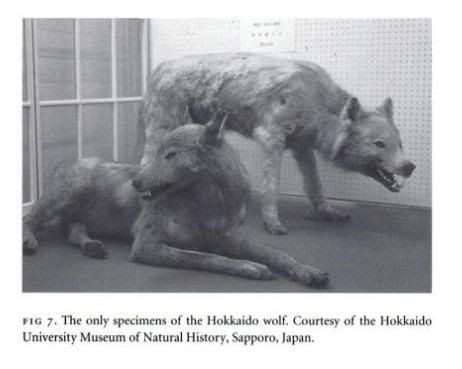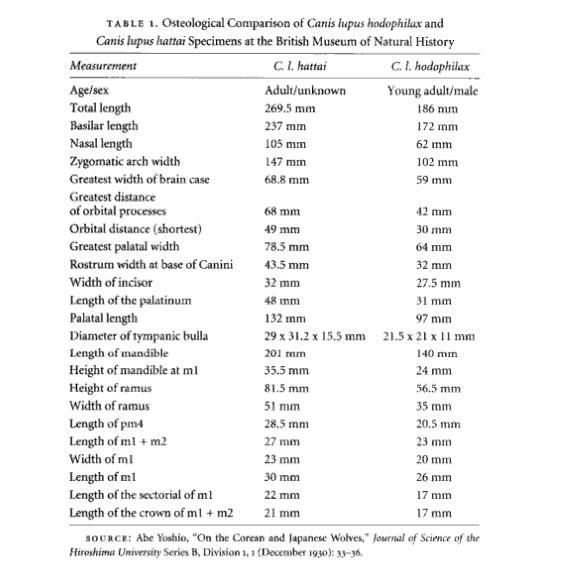|
|
Post by Melanie on Jun 14, 2005 12:52:30 GMT
Ezo Wolf (Canis lupus hattai; Ezo-okami), also known as the Hokkaido Wolf, which occupied the island of Hokkaido in Japan. The Ezo Wolf was larger than the Honshu Wolf (Japanese Wolf), more closely approaching the size of a regular grey wolf. The Ezo Wolf reportedly became extinct in 1889 as a result of deliberate strychnine poisoning by farmers.
|
|
|
|
Post by another specialist on Jun 14, 2005 14:57:35 GMT
|
|
|
|
Post by another specialist on Jun 14, 2005 14:58:29 GMT
|
|
|
|
Post by another specialist on Jun 14, 2005 15:00:25 GMT
|
|
|
|
Post by Melanie on Jun 14, 2005 15:19:48 GMT
|
|
|
|
Post by Melanie on Jun 14, 2005 15:25:56 GMT
Why do you repeat this text? It's about the Honshu Wolf and not about the Hokkaido Wolf.
|
|
|
|
Post by another specialist on Jun 14, 2005 15:28:36 GMT
why do you delete without informing members?
thats pretty inpolite for starters...
Sorry if i do repeat - not on purpose just some times its not that easy to notice when searching for it here....
|
|
|
|
Post by Melanie on Jun 14, 2005 15:35:08 GMT
Sorry, that i don't have informed you. For that i have to apologize. But it is also confusing for starters when you make a fullquote of a text when only a small part of this text suits to the topic.
|
|
|
|
Post by another specialist on Jun 14, 2005 15:45:59 GMT
On the Extinction of the Japanese Wolf please note this is on both subspecies of wolves that were known to live in Japan... www.wolfology.com/id147.htm |
|
|
|
Post by another specialist on Jun 14, 2005 15:55:45 GMT
Sorry, that i don't have informed you. For that i have to apologize. But it is also confusing for starters when you make a fullquote of a text when only a small part of this text suits to the topic. sorry if i make it confusing but my usual way as i was still working on that entry when you deleted it was i would of done a comment down below after text as i've done above mentioning the two subspecies. Also i always add the source which alot of members don't add - some of us may want to refer to the original source. Also the source may add more info in time or ammend which an entry will not always useful plus you have to think about the copyright of text or images atleast your acknowledging the real owner. |
|
|
|
Post by another specialist on Aug 31, 2007 17:36:46 GMT
|
|
|
|
Post by another specialist on Aug 31, 2007 18:07:55 GMT
|
|
|
|
Post by another specialist on Sept 10, 2007 21:39:31 GMT
|
|
|
|
Post by another specialist on Aug 9, 2008 18:01:36 GMT
 The Lost Wolves of Japan By Brett L. Walker, William Cronon |
|
|
|
Post by another specialist on Aug 9, 2008 18:05:14 GMT
 The Lost Wolves of Japan By Brett L. Walker, William Cronon |
|
|
|
Post by another specialist on Aug 9, 2008 18:07:24 GMT
 The Lost Wolves of Japan By Brett L. Walker, William Cronon |
|
|
|
Post by surroundx on Jan 25, 2014 6:20:58 GMT
Citation:
Walker, Brett L. (2004). Meiji modernizatoin, scientific agriculture, and the destruction of Japan’s Hokkaido wolf. Environmental History 9(2): 248-274.
|
|
|
|
Post by Melanie on Jan 30, 2014 0:43:17 GMT
|
|
|
|
Post by surroundx on Dec 5, 2014 5:48:18 GMT
Reconstructing the colonization history of lost wolf lineages by the analysis of the mitochondrial genomeAbstract The grey wolves (Canis lupus) originally inhabited major parts of the Northern hemisphere, but many local populations became extinct. Two lineages of wolves in Japan, namely, Japanese or Honshu (C. l. hodophilax) and Ezo or Hokkaido (C. l. hattai) wolves, rapidly went extinct between 100 and 120 years ago. Here we analyse the complete mitochondrial genome sequences from ancient specimens and reconstruct the colonization history of the two extinct subspecies. We show a unique status of Japanese wolves in wolf phylogeny, suggesting their long time separation from other grey wolf populations. Japanese wolves appeared to have colonized the Japanese archipelago in the Late Pleistocene (ca. 25,000–125,000 years ago). By contrast, Ezo wolves, which are clearly separated from Japanese wolves in phylogeny, are likely to have arrived at Japan relatively recently (<14,000 years ago). Interestingly, their colonization history to Japan tallies well with the dynamics of wolf populations in Europe and America during the last several millennia. Our analyses suggest that at least several thousands of wolves once inhabited in the Japanese archipelago. Our analyses also show that an enigmatic clade of domestic dogs is likely to have originated from rare admixture events between male dogs and female Japanese wolves. Source: Matsumura, Shuichi, Inoshima, Yasuo and Ishiguro, Naotaka. (2014). Reconstructing the colonization history of lost wolf lineages by the analysis of the mitochondrial genome. Molecular Phylogenetics and Evolution 80: 105-112. [ Abstract]
|
|
|
|
Post by koeiyabe on Nov 28, 2015 16:15:42 GMT
 "Living Things Vanished from the Earth (in Japanese)" by Toshio Inomata (1993) with Honshu wolf (above) and Japanese sealion. |
|